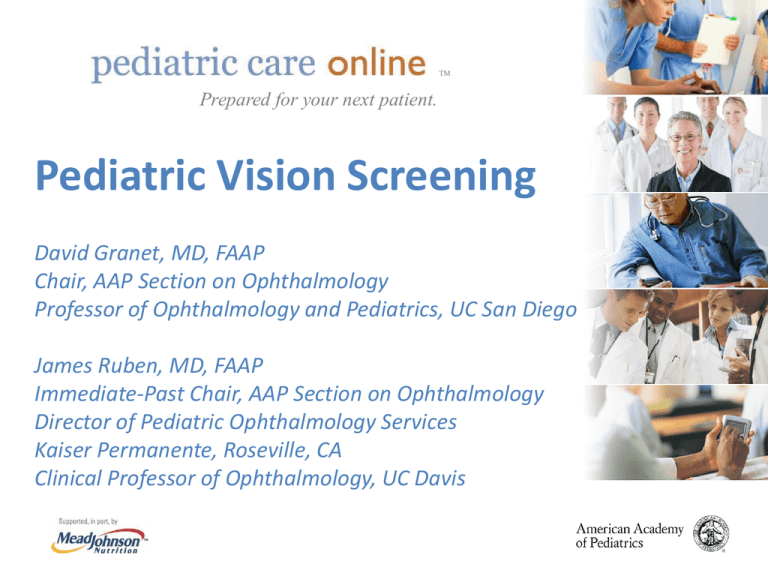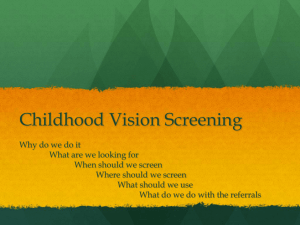Pediatric Vision Screening: AAP Webinar for Pediatric Care Online
advertisement

TM Prepared for your next patient. Pediatric Vision Screening David Granet, MD, FAAP Chair, AAP Section on Ophthalmology Professor of Ophthalmology and Pediatrics, UC San Diego James Ruben, MD, FAAP Immediate-Past Chair, AAP Section on Ophthalmology Director of Pediatric Ophthalmology Services Kaiser Permanente, Roseville, CA Clinical Professor of Ophthalmology, UC Davis Disclaimers Neither presenter has a conflict of interest. Dr. Granet does hold a patent to a photoscreener not discussed in this presentation and for which he is receiving no royalties. Statements and opinions expressed are those of the authors and not necessarily those of the American Academy of Pediatrics. Mead Johnson sponsors programs such as this to give healthcare professionals access to scientific and educational information provided by experts. The presenters have complete and independent control over the planning and content of the presentation, and is not receiving any compensation from Mead Johnson for this presentation. The presenters’ comments and opinions are not necessarily those of Mead Johnson. In the event that the presentation contains statements about uses of drugs that are not within the drugs' approved indications, Mead Johnson does not promote the use of any drug for indications outside the FDA-approved product label. Introduction: Questions We Hope to Answer Why is pediatric vision screening important? When should I be screening children’s eyes? What is the best way to screen? Is there any new and improved pediatric vision screening technology I should be adopting? The Importance of Pediatric Vision Screening Amblyopia affects up to 5% of the population (>10 million Americans). In the first 4 decades of life amblyopia causes more vision loss than all other ocular diseases combined! Amblyopia has a “window period” for treatment in early childhood. Screening can prevent otherwise fatal disorders such as retinoblastoma. Vision Screening: Scope of Problem Only 21% of preschool children and even fewer children below preschool age are screened for these conditions. Ottar WL, Scott WE, Holgado SI. Photoscreening for amblyogenic factors. J Pediatr Ophthalmol Strabismus. 1995;32(5):289–295 Amblyopia is Very Cost-Effective to Treat Membrano, et al: Cost/QALY $2,281 for Amblyopia Tx Comparisons: ‒ Hypertension screening/therapy in asymptomatic 49 yo = $25,000/QALY ‒ Annual screening for Diabetic Retinopathy in high risk diabetics = $41,700/QALY Pediatricians Are the Natural First Line of Defense – The Medical Home Children already come to Pediatrician. Vaccinations and screening are already a part of care protocol. Screening in pediatrics should be most cost effective (no separate office visit, no extra-time off work for parent). 7 AAP Policy on Vision Screening AAP in concert with AAO and AAPOS have a joint policy statement recommending screening beginning at birth and throughout childhood during well child visit. ‒ Serial screening in the MEDICAL HOME Ensures age-appropriate monitoring of visual system. Is more efficient and cost effective than comprehensive eye exams for asymptomatic children. 500,000 newborns/year in CA x $100 eye exam = $50 million ‒ Pediatricians are best champions for a child’s health. Brief Overview of Ocular Anatomy, Physiology and Terminology Retinal Anatomy Eye Movements Refractive Errors Nearsighted Farsighted Astigmatism Anisometropia Myopia (Near-sightedness) Eyeball too long Can’t see far away Correct with specs, contact lens, or excimer laser (adults) Hyperopia (Far-sightedness) The eyeball is too short “Accommodation” will increase the effective lens power in the eye and focus at both near and far Crossing may occur Accommodation Glasses Astigmatism “Warpage” of the cornea like a football Light rays in one axis are not focused the same as in opposite axis Corrected with glasses What is Amblyopia? Unilateral or bilateral decrease of visual acuity caused by form vision deprivation and/or Abnormal binocular interaction for which no organic cause can be detected Amblyopia The Physician sees nothing and the Patient very little Amblyopia…In Other Words: The camera (eye) is capable of taking the picture but the computer (brain) doesn’t recognize that there is an image. “Either use it or lose it!” Children are Different Developing cortical connections Window of opportunity for diagnosis and treatment…just like with language development Screen for Causes of Amblyopia Refractive errors Obstruction of optical pathway (e.g. cataract or corneal scar) Strabismus Other—anything that blocks input of visual information to the brain Motility Terminology Strabismus = ocular misalignment Esotropia = eyes turn in Exotropia = eyes turn out Hypertropia = one eye higher than the other Milestones 30 weeks 31 weeks 2 to 3 weeks - Horizontal gaze Vertical Fixate - Follow - Blink to light Pupils react Early fixation Birth 2 months Birth to 3 months 3 months Other Visual Functions Color ? (3 months) Field – Adult-like 1 year Normal Development of Vision and Eye Movements BIRTH – Term Fixation Poor following Intermittent strabismus frequently present Visual acuity 20/400 to 20/600 One Month Horizontal following to midline Improving alignment Visual acuity 20/300 Two Months Vertical following begins Improving alignment Visual acuity 20/200 Three Months Good horizontal & vertical following Normal alignment Visual acuity 20/100 Accommodation begins Binocularity detectable Six Months Visual acuity 20/30–20/40 Binocularity well developed Eight to Ten Years? End of sensitive period for amblyopia When Should We Screen? Begin at birth and during all subsequent well child visits. ‒ Think of vision screening like vaccinations! ‒ Different screening at different developmental/age levels. Periodicity Table for Screening Periodicity Schedule for Visual System Assessment in Infants and Children Newborn to 6 months 6 months to 12 months x x 1 to <3 years 3 to < 5 years 5 years and older Ocular History x X x External inspection of x x x lids and eyes Red Reflex Testing x x x x Pupil examination x x x Ocular Motility x x x Assessment Instrument Based x x Screening + + Visual Acuity Fix and x x follow Visual Acuity agex appropriate optotype ∆ assessment +: Bill using CPT 99174 ∆: Bill using CPT 99173 *: If unable to test visual acuity monocularly with age appropriate linear optotypes, instrument-based screening is suggested. x x x x x * x ∆ Age Specific Screening: NEWBORN External evaluation for obvious ocular malformations and infections ‒ NOTE: Too young to evaluate alignment!!! RED REFLEX TEST—preferably prior to discharge from newborn nursery ‒ Very important to r/o retinoblastoma or congenital cataracts If congenital cataracts not removed in first 2 to 3 months of life, permanent loss of sight occurs Bruckner Reflex Leukocoria is an Urgency! Diff Dx include cataract, glaucoma, PHPV, Retinoblastoma, Retinal detachment, etc. In addition to sending a consult, CALL ophthalmologist to make sure the patient is seen ASAP! Basic Techniques for Examining Children’s Eyes Age specific Start with HISTORY ‒ Moms are great diagnosticians! Common EXAM components ‒ Assessment of vision ‒ External anatomy ‒ Pupil function ‒ Motility ‒ Ocular fundus/Red Reflex testing Ocular History Does child appear to see well distance and near? Any crossing? Family history of eye disorders? Recurrent discharge or redness? Extreme photophobia? NOT to worry about: ‒ “Sits close to TV a lot” External Examination Are eyelids symmetric? Pupil symmetry? Any redness, inflammation, or discharge? Cornea clear? Are the eyes aligned? Pupil Exam Are the pupils round? Symmetric? ‒ If asymmetric, is it more asymmetric in dark or light? Reactive to light? Motility Assessment Is the pupil light reflex central? Do the eyes move fully in all directions? Pseudostrabismus vs. true strabismus Pseudostrabismus Vision Assessment Infants: Eye contact, follows face, smiles Toddlers: Cover each eye and follows objects (fix and follow) Verbal: Visual acuity screening with appropriate optotype (symbol/letters) Visual Acuity (VA) Testing To have good VA both anterior and posterior visual pathways must be functioning. VA testing is the current “gold standard.” Can be very labor intensive. Should be performed at earliest possible age. Checking VA The 3 common errors: Child peaks. Child memorizes. Examiner only projects one letter at time (crowding phenomenon). VA Testing – “Traditional Eye Chart” Technique Patch one eye. Generally test at 10 feet. Referral criteria: ‒ Age 3–5 years Fewer than 4 out of 6 objects correct on the 10/20 (aka 20/40) line or >2 line difference between eyes ‒ Age 6 or older <20/30 for 4 of 6 objects or >2 line difference between eyes AAPOS Vision Screening Kit Can order from: ‒ AAPOS: http://www.aapos.org/a hp/vision_screening_kit ‒ AAP: http://tinyurl.aap.org/pu b221192 FREE JVAS Computer-based Screening Test http://pedig.jaeb.org/JVAS.aspx Age specific standardized rapid test HOTV surround matching Runs on any Windows PC Downloadable free of charge FREE JVAS Vision Screener http://pedig.jaeb.org/JVAS.aspx Print Matching Card FREE JVAS Vision Screener http://pedig.jaeb.org/JVAS.aspx Calibrate and Run FREE JVAS Vision Screener http://pedig.jaeb.org/JVAS.aspx FREE JVAS Vision Screener http://pedig.jaeb.org/JVAS.aspx New Screening Technology Remember in the pre-verbal child, the only way to detect amblyopia is to indirectly detect the risk factors. ‒ Refractive errors ‒ Media opacities ‒ Strabismus Objective Screening Technology Photoscreening Automated refractors VEP screening Retinal birefringence Photoscreening Similar to Bruckner Reflex. Exploits the red-eye one gets in photography to help assess both alignment and refractive error. Hyperopia Anisometropia Photoscreening Instrument-based screening is now endorsed by the USPSTF as a valid measure for screening preschool children. A randomized controlled multi-centered cross over study demonstrated photoscreening to be superior to direct testing of visual acuity for screening well visit children ages 3–6 in the pediatrician office.* For children older than 5 years, VA testing still preferred. *Salcido AA, Bradley J, Donahue SP. Predictive value of photoscreening and traditional screening of preschool children. J AAPOS. 2005;9(2):114–120 Photoscreening: Barriers Cost ‒ Instrument, labor, time, space Reimbursement ‒ The adoption of such technology will be highly dependent on the payment decisions of third-party payers. Some third-party payers still fail to reimburse for these technologies, calling them “experimental,” despite the USPSTF recommendation and the AAP position statements on photoscreening. Summary Vision screening should begin at birth and continue throughout well child visits. Vision screening is age-appropriate ‒ Early Red Reflex testing mandatory ‒ VA testing in verbal children Objective screening technology is effective, improving, but needs to be reimbursed for widespread adoption. Pediatricians are our best line of defense for preventable blindness! Additional Reading Free PCO Trial Visit Pediatric Care Online today for additional information on this and other topics. www.pediatriccareonline.org Pediatric Care Online is a convenient electronic resource for immediate expert help with virtually every pediatric clinical information need with must-have resources that are included in a comprehensive reference library and time-saving clinical tools. Don’t have a subscription to PCO? Then take advantage of a free trial today! Call Mead Johnson Nutrition at 888/363-2362 or, for more information, go to https://www.pediatriccareonline.org/prepared/freetrial.html




